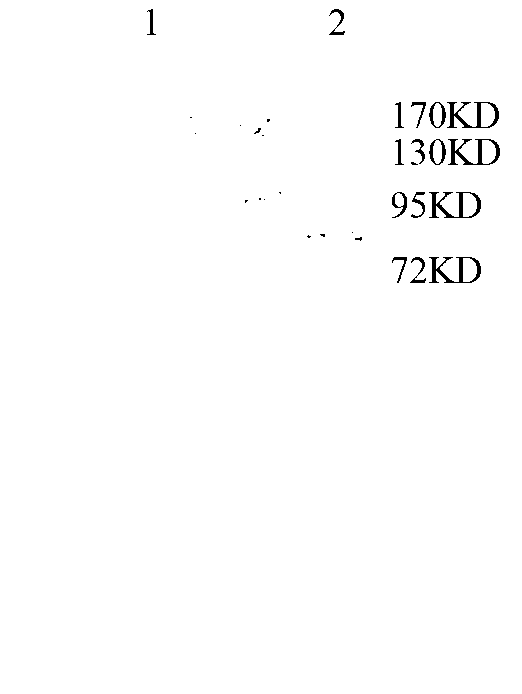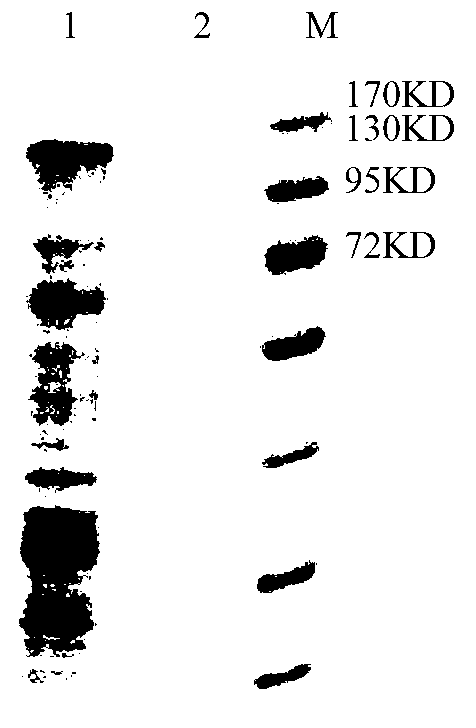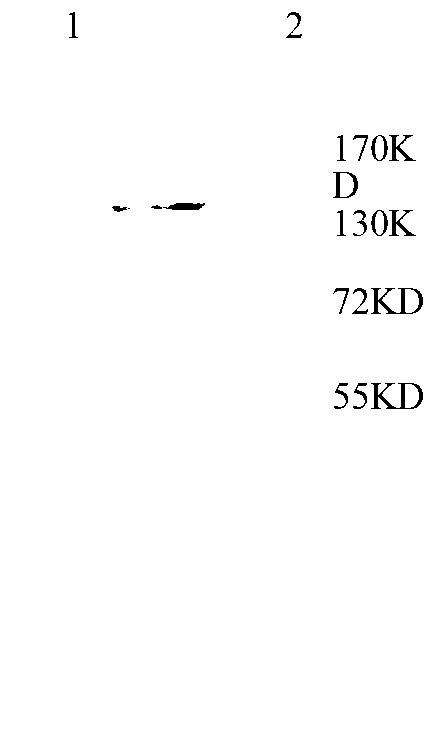Bluetongue virus serum 1 (BTV1) VP2 protein monoclonal antibody (BTV1-3E8), B-cell epitope polypeptide identified by BTV1-3E8 and application of BTV1-3E8
A bluetongue virus, monoclonal antibody technology, applied in antiviral immunoglobulins, antiviral agents, antibodies, etc., can solve the problem of lack of serotype detection methods and reagents
- Summary
- Abstract
- Description
- Claims
- Application Information
AI Technical Summary
Problems solved by technology
Method used
Image
Examples
Embodiment 1B
[0040] Prokaryotic expression and purification of embodiment 1BTV1-VP2 protein
[0041] 1. Primer Design
[0042] According to the BTV1VP2 gene sequence registered in Genbank (accession number: JN848760.1), design PCR amplification primers, the sequence is as follows:
[0043] BTV1-VP2-BamHI-1-23F: 5'CTGGATCCATGGATGAACTAGGCATCCCAGT3'
[0044] BTV1-VP2-Hind-2886-2865R: 5'GCCAAGCTTTCATACGTTGAGAAGTTTTGTC3'
[0045] The underlined part is the introduced restriction site of BamH I and Hind III, and the length of the amplified product is expected to be 2886bp.
[0046] 2. Extraction and reverse transcription of BTV1 viral RNA
[0047] Viral genomic RNA was extracted from BHK-21 cells infected with BTV1 by Trizol method as a template, and viral cDNA was synthesized by reverse transcription with BTV1-VP2-Hind-2886-2865R primers.
[0048] RNA extraction step by Trizol method: Harvest BHK-21 cells infected with BTV1 1-5×10 7 Add 1mL Trizol and mix well, let stand at room temperatur...
Embodiment 2
[0078] The preparation of embodiment 2 monoclonal antibody
[0079] 1. Mice Immunization
[0080] Immunize five 6-week-old female BALB / c mice with the purified prokaryotic recombinant VP2 protein, and immunize three times with two weeks between each immunization. Firstly, mix the recombinant VP2 protein with an equal volume of Freund's complete adjuvant Emulsification, second immunization and third immunization The recombinant NS1 protein was mixed and emulsified with an equal volume of Freund's incomplete adjuvant, the immunization dose was 50 μg per mouse, and the immunization route was intraperitoneal immunization.
[0081] One week after the second and third immunizations, blood was collected from the tail of the mice, the serum was separated (4°C, 10,000 rpm, 10 min), and the antibody level was detected by indirect ELISA. Three days before cell fusion, BALB / c mice with good immune effect were boosted again.
[0082] 2. Cell Fusion
[0083] Feeder cells were prepared 1 ...
Embodiment 3
[0089] Identification of embodiment 3Mab
[0090] 1. Subclass identification of Mab
[0091] SBA Clonotyping TM System / HRP Antibody Subclass Identification Kit Operating Instructions The Mab obtained in Example 1 was used for subclass identification.
[0092] The result shows that the heavy chain of Mab BTV1-3E8 of the present invention is IgG 1 , the light chain is a κ chain.
[0093] 2. Western blot identification
[0094] The cell pellet after the centrifugation harvested the BTV1 virus supernatant and the BHK-21 cell pellet were subjected to SDS-PAGE electrophoresis and then electrotransfer. The electrotransfer condition was 17V for 30min. Put the transferred nitrocellulose membrane into PBST blocking solution containing 50g / L skimmed milk powder to block overnight at 4°C; put the blocked nitrocellulose membrane into the supernatant of positive hybridoma culture medium for 1h at room temperature, (pH7.4 PBST buffer containing 0.5mL / L Tween-20) washed 3 times, then re...
PUM
 Login to View More
Login to View More Abstract
Description
Claims
Application Information
 Login to View More
Login to View More - R&D Engineer
- R&D Manager
- IP Professional
- Industry Leading Data Capabilities
- Powerful AI technology
- Patent DNA Extraction
Browse by: Latest US Patents, China's latest patents, Technical Efficacy Thesaurus, Application Domain, Technology Topic, Popular Technical Reports.
© 2024 PatSnap. All rights reserved.Legal|Privacy policy|Modern Slavery Act Transparency Statement|Sitemap|About US| Contact US: help@patsnap.com










